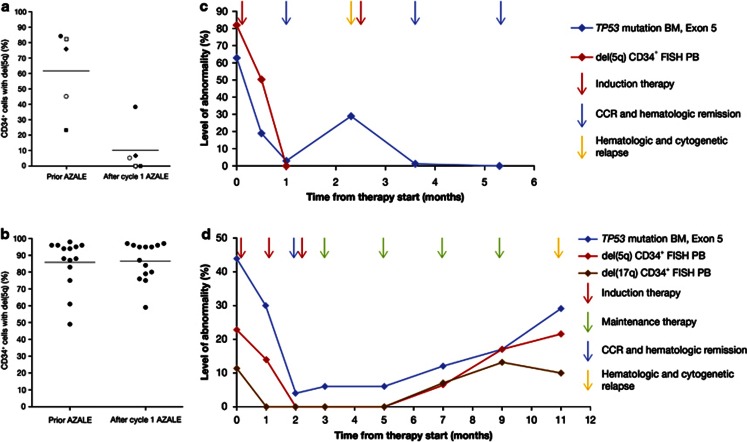Figure 1.
Percentage of CD34+ cells in PB with del(5q) by fluorescence in situ hybridization analysis in (a) hematologic responders (n=5; P=0.001; every patient is marked by a unique symbol to allow for individual pre and posttreatment comparisons) and (b) nonresponders (n=14). (c and d) Levels of TP53 mutation load and percentage of FISH+ cells at the respective sampling time points are reported on the y axis. (c) Universal patient number 15 who achieved CCR and hematologic remission: changes in TP53 mutation levels in the BM and changes in del(5q) CD34+ FISH+ cells in the PB. The patient achieved a CR with incomplete recovery of peripheral blood counts and CCR after the first cycle of induction therapy. The second cycle of treatment had to be delayed due to prolonged cytopenia. Upon recovery from cytopenia the patient displayed a hematologic and cytogenetic relapse. A CCR was obtained again after the second course of treatment. Six months after the first cycle of induction therapy the patient underwent an allogeneic hematopoietic stem cell transplantation. (d) Universal patient number 13 who achieved CCR and hematologic remission: changes in TP53 mutation levels in the BM, and changes in del(5q) and del(17p) CD34+ FISH+ cells in the PB. The patient underwent three cycles of induction therapy, which were followed by four cycles of maintenance therapy every 8 weeks. CR and CCR lasted for 9 months. During this time we observed the re-emergence of the TP53 mutated clone in the BM, as well as the del(5q) and del(17p) CD34+ blood cells, months before hematologic and cytogenetic relapse.

